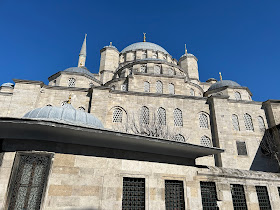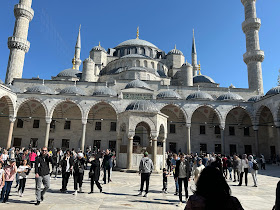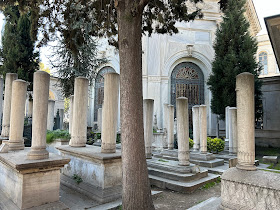I would suspect - though I have no hard data on this - that almost every trip to Turkey starts and ends in Istanbul. Part of that is simply due to the fact that Istanbul airport is the largest airport in Turkey and, in 2023, was the second busiest airport in Europe - so every flight likely touches down here. The other is that, well, Istanbul is Istanbul.
The current city of Istanbul is huge, both internally to Turkey as well as to the world at large. Currently almost one of every five inhabitants of Turkey lives in its environs (15 million in a total population of 85 million), making it the largest city in Turkey; the next, the capital city of Ankara, has 5.1 million inhabitants. It is also the most populous city in Europe as well as the 15th largest city globally.
Although the area of Istanbul was likely settled in the Neolithic era, the city itself was founded in the 7th Century B.C. by colonists from the Greek city of Megara. The legend of the founding is that the leader of that expedition, Byzas, consulted the Oracle of Delphi prior to leaving and was told to build his city in the land opposite the blind. He sailed to the Bosporus Straits and realized that another Greek colony - Chalcedon - had been founded on the Asian side of the Straits and had completely missed the geographic advantages that the location of Byzantium offered: A sheltered harbor and a defensible site. Deciding the "blind" were the Chalcedonians, he founded a colony and married the daughter of a local lord. The city became known as "Byzantion".
The colony prospered: the tibes of Thrace needed trade goods and, as time went on, ships traveling for trade to the Pontus Sea (Black Sea) needed a port as well. Byzantion was well situated for both of these needs. Although subject to those passing through - The Persian Empire during The Greco-Persian Wars and The Athenian Empire during the Delphian League, it became independent in 335 B.C. and remained so until 73 A.D., when it became part of the Roman Empire
The dominant feature of Byzantion (Byzantium/Constantinople/Istanbul) is the Bosporus Straits, the narrow waterway (31 km/19 miles) that connects the Black Sea with the Sea of Marmara and eventually the Aegean/Mediterranean Seas. This narrow sea lane - incredibly strategically important almost since the founding of the city - comes to with 700 meters/2300 feet of the two continents of Asia and Europe within the limits of Istanbul. This has two impacts: the first is that Istanbul is the one of the few cities that is on two continents. The second is that Istanbul has always been in a place - even, apparently, in pre-history - of trade and human contact.
When Constantine the Great (A.D. 272-337) gained control of the Roman Empire, he sought out a new capitol away from Rome, a recognition that the Eastern Half of the Roman Empire had gained in power and importance. The city of Byzantium already existed; he took it and made it into the Imperial Capitol of Constantinople. Officially "founded" in A.D. 324, it would serve as the capitol of what would become the Byzantine Empire until A.D. 1453.
Traces of both Greek, Roman, and Byzantine Byzantium and Constantinople seem hard to come by, at least in modern Istanbul. 2800 years of human habitation combined with multiple building programs (Greek, Roman, Byzantine, Ottoman, and Turkish) combined with a region given to the earthquakes has reduced many such buildings to either ruins or markers indicating their location in the modern world.
The Byzantine Empire lasted for just about 1,000 years following the loss of the Western Roman Empire. Under Justinian I (A.D. 482-565) it tried to regain the geographic range of its predecessor but the world had changed. Over the next 1,000 years it essentially fought a long, rearguard action against newer peoples and kingdoms that sought to replace its power and geography.
Coveted for its wealth, Constantinople fell first not to the invading nomads or Vikings or warriors of Islam who all tried and failed, but rather to its Christian co-religionists in A.D. 1204 during the rather poorly named Fourth Crusade. Almost 1,000 years of wealth and culture were stolen or despoiled. The successor states - The Latin Empire of Constantinople (A.D. 1204 - 1261) or the revised Byzantine Empire under the Palaiologos Dynasty (A.D. 1261-1453) were at best empires marking time, subject to the whims of its more powerful neighbors.
In the case of Constantinople, its nearest neighbors (as we discussed last week) were the Turks, initially the Seljuk and then the Ottoman. In A.D. 1453 the Ottomans realized a Turkish ambition of almost 400 years in their conquest of Constantinople.
Under the Ottomans, the city - which was still called a version of Constantinople until the 18th century, when the colloquial word "Stambul" began to enter formal usage (based, interestingly enough, on the Greek term "in the city"), Constantinople being the only city of note in the region), remained a capitol. The Turks adopted the Byzantine bureaucracy and made it there own. From the Topkapi palace (and later, the Dolmabace Palace), the Ottoman Sultan ruled an expanding empire until A.D. 1683, and then a declining Empire until A.D. 1923. Through all of this - the expansion, the retreat - the Turks built and made Constantinople their own, even as their predecessors had done.
Following the defeat of the Ottoman Empire in A.D. 1918, the Allies negotiated with the Sultan and his government. An independence movement lead by Mustafa Kemal Ataturk, was declared in Ankara. With the dissolution of the Ottoman Empire in A.D. 1922, the final chapter of Byzantium/Constantinople/Istanbul as a capitol city after almost 1600 years - finally closed.
But although its history as a capitol may have closed, its existence as a crossroads of cultures and the lure of exotic lands continues to this day. Even though stripped of its title as capitol, it maintains an attraction far beyond just a center of power.
One would like to think Byzas would not be displeased with the outcome of his vision.














Living in the Midwest, I'm used to seeing the entire history of a town at a glance. 180 year old remnants are still very much visible. It takes me awhile to absorb 2000+ years of history that many towns in Europe have.
ReplyDeleteEd, I have the same experience. The thing that makes Istanbul so remarkable to me is that it has been inhabited so long and there are layers over layers of civilization.
DeleteAn odd part of me wishes I could have seen Constantinople at at its height under both the Byzantines and the Ottomans.
Ten decades is a long time in North America while time is measured more in centuries there. Would have liked to walk the streets of the city when Constantine the Great converted to Christianity in A.D. 312. Here in the USA when a building hits the 100- year mark, HAY! HO! Call the National Register! A fine post TB.
ReplyDeleteThanks Nylon12! The Old City (where much of where we were) may not have the buildings, but the crowded and twisting streets are probably not all that different from how it was back then.
DeleteThank you for the great history lesson!
ReplyDeleteIstanbul is on our wish list and we hope to see it in person one of these days.
As both Ed and Nylon12 said, we are the new kids on the block.
You are welcome John! I cannot recommend Turkey as a destination highly enough.
DeleteSuch an ancient history is hard to comprehend. Fascinating though. I'm going to enjoy this series.
ReplyDeleteThanks Leigh! Honestly, it was a bit overwhelming when I sat down and thought about it - it really is so much. We have nothing in the US that is comparable.
Delete